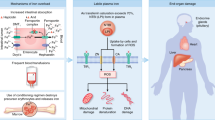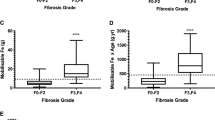Summary:
Iron overload is associated with free radical generation and tissue damage. Our main objective was to ascertain the frequency and severity of iron overload in a group of 59 patients who died after conventional-intensity autologous (n=24) or allogeneic (n=35) haematopoietic stem cell transplantation (HSCT). A second objective was to investigate associations between liver-iron concentration and causes of transplant-related mortality. The median age was 41 years (range, 19–66), 41 were males and 18 females. In total, 26 patients had acute leukaemia or MDS, 10 CML, 17 lymphoma, four myeloma and two aplastic anaemia. The median hepatic iron concentration (HIC) was 138 μmol/g dry weight (7.7 mg/g; range 31–631 μmol/g). In total, 4/32 (12%) patients with HIC <150 μmol/g and 10/27 (37%) with hepatic iron ⩾150 μmol/g showed invasive aspergillosis at autopsy (P=0.035). This was significant in multivariate analysis (RR 9.0; 95% CI 1.6–50.3, P=0.012). In conclusion, severe iron overload is frequent in patients who die following HSCT and is associated with invasive aspergillosis.
This is a preview of subscription content, access via your institution
Access options
Subscribe to this journal
Receive 12 print issues and online access
$259.00 per year
only $21.58 per issue
Buy this article
- Purchase on Springer Link
- Instant access to full article PDF
Prices may be subject to local taxes which are calculated during checkout
Similar content being viewed by others
References
Lucarelli G, Galimberti M, Polchi P et al. Bone marrow transplantation in patients with thalassemia. N Engl J Med 1990; 322: 417–421.
Angelucci E, Muretto P, Nicolucci A et al. Effects of iron overload and hepatitis C virus positivity in determining progression of liver fibrosis in thalassemia following bone marrow transplantation. Blood 2002; 100: 17–21.
Halliwell B, Gutteridge JM, Cross CE . Free radicals, antioxidants, and human disease: where are we now? J Lab Clin Med 1992; 119: 598–620.
Carmine TC, Evans P, Bruchelt G et al. Presence of iron catalytic for free radical reactions in patients undergoing chemotherapy: implications for therapeutic management. Cancer Lett 1995; 94: 219–226.
Bullen JJ . The significance of iron in infection. Rev Infect Dis 1981; 3: 1127–1138.
Brissot P, Bourel M, Herry D et al. Assessment of liver iron content in 271 patients: a reevaluation of direct and indirect methods. Gastroenterology 1981; 80: 557–565.
Barry M, Sherlock S . Measurement of liver-iron concentration in needle-biopsy specimens. Lancet 1971; 1: 100–103.
Gimferrer E, Sancho FX . Las hepatosiderosis. I. Planteamientos patogénicos y diagnósticos. Bio-Ferrum 1997; 2: 53–60.
Ascioglu S, Rex JH, de Pauw B et al. Defining opportunistic invasive fungal infections in immunocompromised patients with cancer and hematopoietic stem cell transplants: an international consensus. Clin Infect Dis 2002; 34: 7–14.
Ljungman P, Griffiths P, Paya C . Definitions of cytomegalovirus infection and disease in transplant recipients. Clin Infect Dis 2002; 34: 1094–1097.
Przepiorka D, Weisdorf D, Martin P et al. 1994 consensus conference on acute GVHD grading. Bone Marrow Transplant 1995; 15: 825–828.
Sullivan KM, Agura E, Anasetti C et al. Chronic graft-versus-host disease and other late complications of bone marrow transplantation. Semin Hematol 1991; 28: 250–259.
Altès A, Remacha AF, Sureda A et al. Iron overload might increase transplant-related mortality in haematopoietic stem cell transplantation. Bone Marrow Transplant 2002; 29: 987–989.
Strasser SI, Kowdley KV, Sale GE, McDonald GB . Iron overload in bone marrow transplant recipients. Bone Marrow Transplant 1998; 22: 167–173.
Kornreich L, Horev G, Yaniv I et al. Iron overload following bone marrow transplantation in children: MR findings. Pediatr Radiol 1997; 27: 869–872.
Bothwell TH, MacPhail AP . Hereditary hemochromatosis: etiologic, pathologic and clinical aspects. Semin Hematol 1998; 35: 55–71.
Bradley SJ, Gosriwitana I, Srichairatanakool S et al. Non-transferrin-bound iron induced by myeloablative chemotherapy. Br J Haematol 1997; 99: 337–343.
Sahlstedt L, Ebeling F, Bonsdorff L et al. Non-transferrin-bound iron during allogeneic stem cell transplantation. Br J Haematol 2001; 113: 836–838.
Griffiths E, Williams P . The iron-uptake systems of pathogenic bacteria, fungi and protozoa. In: Bullen JJ, Griffiths E (eds.). Iron and Infection. John Wiley & Sons: Chichester, 1999; pp 87–212.
Boelaert JR, de Locht M, Van Cutsem J et al. Mucormycosis during deferoxamine therapy is a siderophore-mediated infection. In vitro and in vivo animal studies. J Clin Invest 1993; 91: 1979–1986.
Gifford AHT, Klippenstein JR, Moore MM . Serum stimulates growth of and proteinase secretion by Aspergillus fumigatus. Infect Immun 2002; 70: 19–26.
Hissen AH, Chow JM, Pinto LJ, Moore MM . Survival of Aspergillus fumigatus in serum involves removal of iron from transferrin: the role of siderophores. Infect Immun 2004; 72: 1402–1408.
Eisendle M, Oberegger H, Zadra I, Haas H . The siderophore system is essential for viability of Aspergillus nidulans: functional analysis of two genes encoding l-ornithine N 5-monooxigenase (sidA) and a non-ribosomal peptide synthetase (sidC). Mol Microbiol 2003; 49: 359–375.
Abe F, Katoh T, Kaneko T, Hotchi M . Effects of endotoxin (lipopolysaccharides) on experimental aspergillosis in leukemic mice. Mycopathologia 1987; 99: 95–97.
Okawa Y, Murata Y, Suzuki M et al. Delayed lethal response to Aspergillus fumigatus infection in sarcoma 180 tumor-bearing mice. FEMS Immunol Med Microbiol 2002; 34: 113–117.
Yamada K, Zoarski GH, Rothman MI et al. An intracranial aspergilloma with low signal on T2-weighted images corresponding to iron accumulation. Neuroradiology 2001; 43: 559–561.
Iglesias-Osma C, Gonzalez-Villaron L, San Miguel JF et al. Iron metabolism and fungal infections in patients with haematological malignancies. J Clin Pathol 1995; 48: 223–225.
Maertens J, Demuynck H, Verbeken EK et al. Mucormycosis in allogeneic bone marrow transplant recipients: report of five cases and review of the role of iron overload in the pathogenesis. Bone Marrow Transplant 1999; 24: 307–312.
Brandhagen DJ, Alvarez W, Therneau TM et al. Iron overload in cirrhosis-HFE genotypes and outcome after liver transplantation. Hepatology 2000; 31: 456–460.
Husni RN, Gordon SM, Longworth DL et al. Cytomegalovirus infection is a risk factor for invasive aspergillosis in lung transplant recipients. Clin Infect Dis 1998; 26: 753–755.
George MJ, Snydman DR, Werner BG et al. The independent role of cytomegalovirus as a risk factor for invasive fungal disease in orthotopic liver transplant recipients. Boston center for liver transplantation CMVIG study group. Am J Med 1997; 103: 106–113.
Marr KA, Carter RA, Boeckh M et al. Invasive aspergillosis in allogeneic stem cell transplant recipients: changes in epidemiology and risk factors. Blood 2002; 100: 4358–4366.
Grow WB, Moreb JS, Roque D et al. Late onset of invasive Aspergillus infection in bone marrow transplant patients at a university hospital. Bone Marrow Transplant 2002; 29: 15–19.
Fukuda T, Boeckh M, Carter RA et al. Risks and outcomes of invasive fungal infections in recipients of allogeneic hematopoietic stem cell transplants after nonmyeloablative conditioning. Blood 2003; 102: 827–833.
de la Serna J, Bornstein R, García-Bueno MJ, Lahuerta-Palacios JJ . Iron depletion by phlebotomy with recombinant erythropoietin prior to allogeneic transplantation to prevent liver toxicity. Bone Marrow Transplant 1999; 23: 95–97.
Sahlstedt L, von Bonsdorff L, Ebeling F et al. Effective binding of free iron by a single intravenous dose of human apotransferrin in haematological stem cell transplant patients. Br J Haematol 2002; 119: 547–553.
Author information
Authors and Affiliations
Corresponding author
Rights and permissions
About this article
Cite this article
Altes, A., Remacha, A., Sarda, P. et al. Frequent severe liver iron overload after stem cell transplantation and its possible association with invasive aspergillosis. Bone Marrow Transplant 34, 505–509 (2004). https://doi.org/10.1038/sj.bmt.1704628
Received:
Accepted:
Published:
Issue Date:
DOI: https://doi.org/10.1038/sj.bmt.1704628
Keywords
This article is cited by
-
Role of biomarkers in the diagnosis of invasive aspergillosis in immunocompromised patients
Annals of Clinical Microbiology and Antimicrobials (2022)
-
Prevalence and risk factors of iron overload after hematopoietic stem cell transplantation for childhood acute leukemia: a LEA study
Bone Marrow Transplantation (2017)
-
A computational model of invasive aspergillosis in the lung and the role of iron
BMC Systems Biology (2016)
-
Clinical significance of pretransplant serum ferritin on the outcome of allogeneic hematopoietic SCT: a prospective cohort study by the Kanto Study Group for Cell Therapy
Bone Marrow Transplantation (2015)
-
Pretransplant serum ferritin is associated with bloodstream infections within 100 days of allogeneic stem cell transplantation for myeloid malignancies
International Journal of Hematology (2011)



